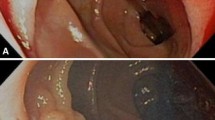Abstract
Background
The rate of cecal intubation is a well-recognized quality measure of successful colonoscopy. Infrequently, the standard colonoscopy techniques fail to achieve complete examination. The role of single-balloon overtube-assisted colonoscopy (SBC) in these situations has only been sparsely studied. This prospective single-center study aimed to investigate the technical success (rate of cecal intubation) and the diagnostic gain of SBC.
Methods
The study recruited consecutive patients with previous incomplete standard colonoscopy who were admitted for SBC at our tertiary center in Eastern Switzerland between February 2008 and October 2014. The primary outcome was defined as successful cecal intubation. Data on patient characteristics, indication, technical details of procedure, and outcome were collected prospectively. The Olympus enteroscope SIF-Q180 was used.
Results
The study included 100 consecutive patients (median age 70 years; range 38–87 years; 54 % female) who were examined using a single-balloon overtube-assisted technique. The cecal intubation rate was 98 % (98/100). The median time of total procedure was 54 min (range 15–119 min); the median time to reach the cecal pole was 27.5 min (range 4–92 min). Passage of the sigmoid colon was not possible in two cases with a fixed, angulated sigmoid colon. The diagnostic gain was 21 % regarding adenomatous polyps in the right colon. The complication rate was 2 % (2/100, minor) without need for surgery.
Conclusions
This prospective patient cohort study shows that single-balloon colonoscopy is a safe and effective procedure to achieve a complete endoscopic examination in patients with a previous failed standard colonoscopy. A significant diagnostic and therapeutic gain in the right colon justifies additional procedure time.


Similar content being viewed by others
References
Davila RE, Rajan E, Baron TH, Adler DG, Egan JV, Faigel DO, Gan SI, Hirota WK, Leighton JA, Lichtenstein D, Qureshi WA, Shen B, Zuckerman MJ, VanGuilder T, Fanelli RD (2006) ASGE guideline: colorectal cancer screening and surveillance. Gastrointest Endosc 63:546–557
Rex DK, Petrini JL, Baron TH, Chak A, Cohen J, Deal SE, Hoffman B, Jacobson BC, Mergener K, Petersen BT, Safdi MA, Faigel DO, Pike IM, ASGE/ACG Taskforce on Quality in Endoscopy, (2006) Quality indicators for colonoscopy. Am J Gastroenterol 101:873–885
Marshall JB, Barthel JS (1993) The frequency of total colonoscopy and terminal ileal intubation in the 1990s. Gastrointest Endosc 39:518–520
Aslinia F, Uradomo L, Steele A, Greenwald BD, Raufman JP (2006) Quality assessment of colonoscopic cecal intubation: an analysis of 6 years of continuous practice at a university hospital. Am J Gastroenterol 101:721–731
Anderson JC, Messina CR, Cohn W, Gottfried E, Ingber S, Bernstein G, Coman E, Polito J (2001) Factors predictive of difficult colonoscopy. Gastrointest Endosc 545:558–562
Loffeld RJ, van der Putten AB (2009) The completion rate of colonoscopy in normal daily practice: factors associated with failure. Digestion 80:267–270
Anderson JC, Gonzalez JD, Messina CR, Pollack BJ (2000) Factors that predict incomplete colonoscopy: thinner is not always better. Am J Gastroenterol 95:2784–2787
Kaltenbach T, Soetikno R, Friedland S (2006) Use of a double balloon enteroscope facilitates caecal intubation after incomplete colonoscopy with a standard colonoscope. Dig Liver Dis 38:921–925
Kita H, Yamamoto H (2007) New indications of double balloon endoscopy. Gastrointest Endosc 66(3 Suppl):S57–S59
Mönkemüller K, Knippig C, Rickes S, Fry LC, Schulze A, Malfertheiner P (2007) Usefulness of the double-balloon enteroscope in colonoscopies performed in patients with previously failed colonoscopy. Scand J Gastroenterol 42:277–278
Pasha SF, Harrison ME, Das A, Corrado CM, Arnell KN, Leighton JA (2007) Utility of double-balloon colonoscopy for completion of colon examination after incomplete colonoscopy with conventional colonoscope. Gastrointest Endosc 65:848–853
Moreels TG, Macken EJ, Roth B, Van Outryve MJ, Pelckmans PA (2010) Cecal intubation rate with the double-balloon endoscope after incomplete conventional colonoscopy: a study in 45 patients. J Gastroenterol Hepatol 25:80–83
Keswani R (2011) Single-balloon colonoscopy versus repeat standard colonoscopy for previous incomplete colonoscopy: a randomized, controlled trial. Gastrointest Endosc 73:507–512
Teshima C, Aktas H, Haringsma J, Kuipers EJ, Mensink PB (2010) Single-balloon-assisted colonoscopy in patients with previously failed colonoscopy. Gastrointest Endosc 71:1319–1323
May A, Nachbar L, Ell C (2006) Push-and-pull enteroscopy using a single-balloon technique for difficult colonoscopy. Endoscopy 38:395–398
Ridolfi TJ, Valente MA, Church JM (2014) Achieving a complete colonic evaluation in patients with incomplete colonoscopy is worth the effort. Dis Colon Rectum 57:383–387
Rembacken B, Hassan C, Riemann JF, Chilton A, Rutter M, Dumonceau JM, Omar M, Ponchon T (2012) Quality in screening colonoscopy: position statement of the European Society of Gastrointestinal Endoscopy (ESGE). Endoscopy 44:957–968
Shah HA, Paszat LF, Saskin R, Stukel TA, Rabeneck L (2007) Factors associated with incomplete colonoscopy: a population based study. Gastroenterology 132:2297–2303
Brahmania M, Park J, Svarta S, Tong J, Kwok R, Enns R (2012) Incomplete colonoscopy: maximizing completion rates of gastroenterologists. Can J Gastroenterol 26:589–592
Gawron AJ, Veerappan A, Keswani RN (2014) High success rate of repeat colonoscopy with standard endoscopes in patients referred for prior incomplete colonoscopy. BMC Gastroenterol. doi:10.1186/1471-230X-14-56
Hsieh YH, Koo M, Leung FW (2014) A patient-blinded randomized, controlled trial comparing air insufflation, water immersion, and water exchange during minimally sedated colonoscopy. Am J Gastroenterol 109:1390–1400
Yamada A, Watabe H, Takano N, Togo G, Yamaji Y, Yoshida H, Kawabe T, Omata M, Koike K (2013) Utility of single and double balloon endoscopy in patients with difficult colonoscopy: a randomized controlled trial. World J Gastroenterol 19:4732–4736
Acknowledgments
We wish to thank the statistician Professor Hanno Ulmer, as well as Mrs. Meltem Yilmaz, Mrs. Michela Bazzeghini, and Mr. Matthias Meyenberger for their extraordinary professional technical support.
Author information
Authors and Affiliations
Corresponding author
Ethics declarations
Disclosures
Drs. Michael Christian Sulz, Remus Frei, Gian-Marco Semadeni, Mikael Sawatzki, Jan Borovicka, and Christa Meyenberger have no conflicts of interest or financial ties to disclose.
Rights and permissions
About this article
Cite this article
Sulz, M.C., Frei, R., Semadeni, GM. et al. The role of single-balloon colonoscopy for patients with previous incomplete standard colonoscopy: Is it worth doing it?. Surg Endosc 30, 1876–1882 (2016). https://doi.org/10.1007/s00464-015-4405-5
Received:
Accepted:
Published:
Issue Date:
DOI: https://doi.org/10.1007/s00464-015-4405-5




